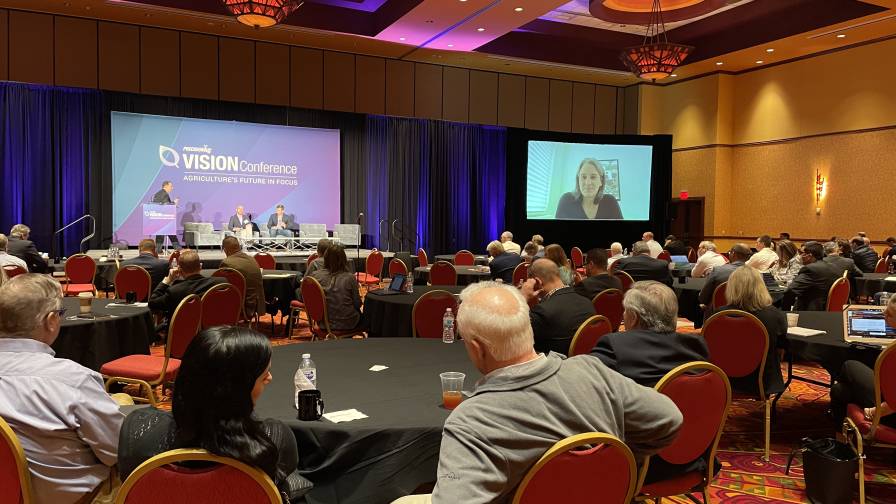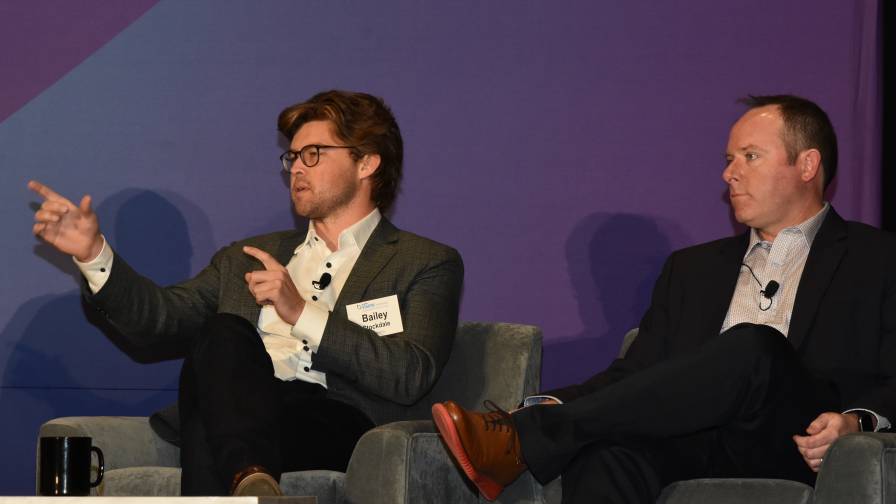AgTech, Farming, and the Future

The 2022 VISION Conference expanded its focus, offering insights on the integration of technology and its impact on the full agribusiness food value chain.
The world has changed dramatically since the PrecisionAg VISION Conference last convened in 2020. Trade wars, tariffs, and a global pandemic have accelerated advancements in technology and given life to threads that now bind the entire food industry from inputs all the way to consumers.
The 2022 VISION Conference, held in January in Glendale, AZ, remains the only event where North America’s precision agriculture and digital farming industry ecosystem meets to address emerging technology and data trends that will transform agribusiness in the next three to five years. But while so much was changing around us, the focus of the conference has evolved as well. New external forces now require the industry be transparent, traceable, responsive, and nimble. The program for VISION 2022 broadened in response, addressing how the industry is responding to these social, cultural, and environmental forces impacting the future of agriculture. A roster of expert speakers and panels explored these topics through the prism of the full agribusiness food value chain, from the farm all the way through to the consumer, and how the pieces are influencing each other.
Attendees at VISION 2022 — owners and company leadership from a mix of ag technology manufacturer/solution providers, ag retailers and distributors, farming/growing operations, independent crop consultants/precision agriculture consultants, and crop input suppliers — spent two valuable days re-engaging with in-person networking and diving deep into discussions on the most important topics for the near-term future of agriculture.
Carbon and Compensation
The VISION 2022 program was built on four pillars — regenerative agriculture, automation, connectivity, and transparency. Sustainability and the ever-present shadow of carbon programs infused much of the discussion throughout the conference.
Agriculture has the potential to be a powerful climate solution, but research and data are critical to make that happen, said Allison Thomson, AgMission Program Director, Foundation for Food & Agriculture Research. Reportedly one in four farmers are actively reducing their carbon footprint, but voluntary conservation efforts require providing farmers with financial incentives, technical assistance, and peer learning opportunities.
“Start with the money,” said Ben Gordon, Carbon and Ecosystem Services Global Portfolio Leader, Corteva Agriscience. Research by Field to Market, one of the leaders in the sustainability space. Forty dollars per acre appears to be the tipping point for half of farmers to adopt cover crops, Gordon said.
Companies are working to reduce the cost and increase the accuracy of mapping carbon content for accurate measurement, but Lars Dyrud, CEO, EarthOptics, suggested an alternative that brings the end-of-chain benefits to the consumer into play. “We know how much carbon an acre of corn sequesters. People buy labels like ‘GMO free’ all the time. Why can’t we charge consumers a premium for corn flakes that took ‘X’ amount of carbon out of the air? This could be an on-going revenue stream paid to all farmers that participate,” he said.
In a panel discussion on fixing the soil health tech stack, Seana Day, Venture Partner, Better Food Ventures, noted a U.S. Farmers & Ranchers in Action (USFRA) study that points out the practical issues with measuring soil health and offering compensation.
“What is the business case for farmers to take each step? That is a complicated question with few answers at the moment,” she said. “Rather, I am focusing specifically on the tech framework needed in order to accurately compensate farmers and ranchers for demonstrating soil health improvement through verifiable measurements and methods.”
The first step, the panel agreed, is to digitize the information that proves over time that soil and farming practices can improve soil carbonization. However, from a practical standpoint, Anastasia Volkova, CEO, Regrow, pointed out that carbon change occurs over five to 10 years, so we need a method to reward behavior annually.
One glaring issue with the base of the measurement component of the tech stack is that variability between soil testing labs is so great, test results often cannot be compared across labs. This makes years of soil test data only valuable for that particular piece of ground and must be correlated with accurate records of field practices in order to tie field practices to changes in carbonization.
Kristofer Covey, Assistant Professor Environmental Studies & Sciences, Skidmore College, and Co-Founder, The Soil Inventory Project (TSIP), suggested adopting methods the U.S. Forestry Service uses to inventory forestry resources and compensate timber growers for sequestering carbon. “Conceptually, it’s easy. You can count trees and you can measure tree growth,” he said. “While there is a lot of soil data from row crops, it’s still not enough for a complete soil inventory and other crops have very little soil data.”
The Role of Equipment and Automation
Representatives from three of the largest farm equipment manufacturers shared their views in a panel organized by the Association of Equipment Manufacturers (AEM) and focused on the role that OEMs have in helping agriculture be more sustainable.
“Our job is to make sustainable doable for our customers,” said Todd Stucke, Senior Vice President, Marketing, Product Support & Strategic Projects for Kubota, who serves as chair of the AEM Ag Sector board. “We have to provide the equipment, the connectivity, the data management, everything for our customers to practice more sustainable farming.”
John Deere’s Vice President, Production & Precision Ag Production System, Deanna Kovar, is excited about the direction the industry is taking on sustainability and autonomy. “The stars are aligned,” Kovar said. “What is good for sustainability on the farm is also good economically.”
“Traditionally, the sustainability discussion with farmers was about water management,” added Kurt Coffey, Vice President, Case IH North America. “Now the discussion has been redirected toward automation for sustainability and labor reasons. And the demand for labor in the agricultural field is getting greater and even more specialized. We need people who speak tractor and combine but also speak tech,” he said.
John Deere recently introduced its first completely automated tractor, but we’re still early on in achieving what’s possible, Kovar said. “We are at the top of the third inning, not the end of the game as far as automation in agriculture.”
Worsening labor shortages in agriculture are pushing robotics forward at an even faster pace. “The goal is to solve the problem of labor,” said Paul Welbig, Director of Sales, Slingshot & Strategic Accounts, Raven Industries, who participated in a robotics panel at the conference. “We describe it as a path to autonomy and we’re on that path.”
That said, automation must be developed and tested on real farms and incorporate farmer feedback to be successful commercially.
Interconnectivity and the Power of Data
Teddy Bekele, Chief Technology Officer, Land O’ Lakes, and one of the keynote speakers for the event drove home the point that in the future of farming and food, data is king.
“Data is key to everything in modern and transformative agriculture. Data makes us relevant,” Bekele said. But, he added, there are four major barriers to being able to collect and use the right data — interoperability, tech-savvy labor, cyber security, and broadband access in rural areas.
In a panel on data capture and compatibility, Michael Gomes, Vice President, Strategic Business Development – Agriculture, Topcon Positioning Group, said while efforts are moving forward toward standardizing the data formats used by companies in the space, it’s still a long way from being seamless, and it all starts with the farmer.
Farmers have the choice of who to share their data with and they need to see or receive value from sharing and inputting. “Accurate information input isn’t worth the time for the operator,” the panel noted.
But standardization of data formats can lead to victories outside the farmer’s fields as well. “There are lots of asks being made of the data,” noted Ben Sloan, Senior Vice President of Product for Digital Ag, EFC Systems. “The holy grail is to develop a system that connects orders, billing, compliance, and application at the retailer level.” This increases the efficiency of physical assets, reduces the need for human assets, and reduces the chance of human error.

Leaf Ag’s G. Bailey Stockdale (L) and Proagrica’s Patrick Sanders discuss how technology is evolving to mitigate the scourge of incompatibility and bad data at VISION Conference 2022.
Another part of the problem has been the independence with which developers have worked, creating systems with little thought to exchanging data with other applications. “[A] goal would be to create the platform that developers can use to design their own applications, but the base platform is the same and therefore the data compatibility is built-in,” said G. Bailey Stockdale, Founder & CEO, Leaf Ag.
Further, the panel asked whether we can unlock the potential of the enormous amounts of data that already exist.
“Can we simulate potential farming scenarios? Can we create a digital farm that mimics the real world? Will farmers or retailers find value in this capability?”
Bridging the Gap Between Farmers and Consumers
In the end, one of the real measures of success with advances in sustainability, automation, and connectivity will be how well the industry can transparently communicate the benefits to regulators, retailers, and consumers. It was pointed out during the conference that the farmer of the future will be influenced by consumer demands more than ever before. Successful farmers will embrace the power of taste, freshness, price, and trust as top drivers of consumer food choices.
Perceived health benefit is an area with immediate potential. Brett Sciotto, CEO, Aimpoint Research, pointed out in his VISION keynote address that functional foods will be a big trend in next 10 years. Consumers will pay more for foods they trust, but the shift from claims to proof requires traceability and transparency, and data becomes part of the product, he said.
Trust plays in hot-button areas, too. “The first company that educates consumers that GMO has created drought resistant crops and the resulting impact on food and water will be a big winner,” said Christina Lampert, Director of Innovation for HowGood. Research has shown sustainability marketed brands get 29.5% price premium vs. conventionally marketed products, she said.
“Ag hasn’t done a very good job of telling our story. We have everything we need to create a story of shared values with sustainability-minded consumers. But there’s so much emotion built up around food, we haven’t been able to have an intelligent exchange with consumers,” she said. “There›s opportunity for everyone to tell their story.”






